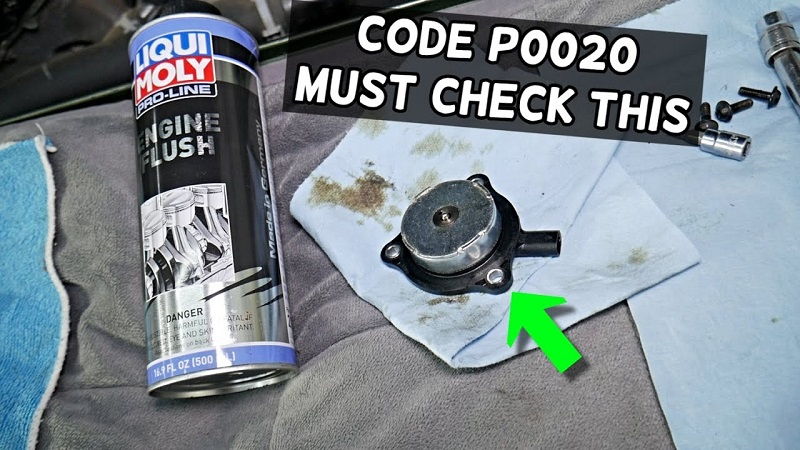This post contains affiliate links. This means I will make a commission at no extra cost to you should you click through and make a purchase [ “As an Amazon Associate, I earn from qualifying purchases.” ]. Read the full disclosure here.
Understanding P0020 “A” Camshaft Position Actuator Circuit (Bank 2) GuideMechanic.Com Modern vehicles rely heavily on advanced electronic systems to ensure optimal performance and efficiency.
One crucial component of these systems is the camshaft position actuator, responsible for regulating the timing of the engine’s valves.
In this article, we will delve into the specifics of the “A” Camshaft Position Actuator Circuit (Bank 2), exploring its functionality, common issues, and troubleshooting methods.
See Also: P001E Code “A” Camshaft Profile Control Circuit Low Bank 2
What is the “A” Camshaft Position Actuator Circuit?

The “A” Camshaft Position Actuator Circuit, part of the engine control system, plays a pivotal role in adjusting the timing of the camshaft in relation to the crankshaft.
It ensures that the engine operates efficiently across different driving conditions, optimizing fuel consumption and performance. Bank 2 typically refers to the bank of cylinders opposite to Bank 1 in a V-type engine configuration.
Functionality:
The camshaft position actuator circuit utilizes solenoids to control oil flow to the camshaft phasers, which are responsible for altering camshaft timing.
By adjusting the timing of the intake and exhaust valves, the engine management system can optimize combustion efficiency, emissions, and power delivery.
Common Issues:
Despite their importance, camshaft position actuators are prone to various issues that can affect engine performance. One common problem associated with the “A” Camshaft Position Actuator Circuit (Bank 2) is electrical malfunctions. This can be due to wiring faults, connector issues, or component failure.
Another prevalent issue is related to the camshaft phaser itself. Over time, these components can wear out or become clogged with debris, leading to improper operation and timing discrepancies. Additionally, oil pressure fluctuations or contamination can hinder the actuator’s ability to function correctly.
Symptoms of a Faulty “A” Camshaft Position Actuator Circuit (Bank 2):
Check out this ANCEL AD410 Enhanced OBD II Vehicle Code Reader Automotive OBD2 Scanner Auto Check Engine Light Scan Tool (Black/Yellow)

Detecting issues with the camshaft position actuator circuit is crucial for timely intervention and preventing further damage to the engine. Some common symptoms of a malfunctioning “A” Camshaft Position Actuator Circuit (Bank 2) include:
Check Engine Light (CEL):
The illumination of the check engine light is often the first indication of a problem with the engine management system. Diagnostic trouble codes (DTCs), such as P0020, may be logged by the onboard diagnostics system.
Rough Idle:
A faulty camshaft position actuator can disrupt the engine’s idle stability, leading to rough or inconsistent idling. This may be accompanied by noticeable vibrations or fluctuations in engine speed.
Reduced Performance:
Engine performance may suffer due to incorrect camshaft timing. Drivers may experience decreased acceleration, reduced power output, or sluggish response to throttle inputs.
Poor Fuel Economy:
Inefficient camshaft timing can adversely affect fuel combustion, resulting in decreased fuel economy. Drivers may notice an increase in fuel consumption over time.
Engine Misfires:
Timing discrepancies caused by a faulty camshaft position actuator circuit can lead to engine misfires. This can manifest as a noticeable loss of power, rough running, or a lack of smoothness during acceleration.
P0020 “A” Camshaft Position Actuator Circuit (Bank 2)
Troubleshooting and Repair:

Addressing issues with the “A” Camshaft Position Actuator Circuit (Bank 2) typically requires a systematic approach to diagnosis and repair. Here are some steps that technicians may take to resolve these issues:
Diagnostic Scan:
Performing a diagnostic scan using a compatible scan tool can help identify specific fault codes related to the camshaft position actuator circuit. This allows technicians to pinpoint the root cause of the problem more accurately.
Visual Inspection:
A visual inspection of the wiring harness, connectors, and related components can reveal any obvious signs of damage, corrosion, or disconnection. Repairing or replacing damaged components may resolve electrical issues.
Testing Solenoids:
Testing the camshaft position actuator solenoids for proper operation is essential. This can be done using a multimeter to measure resistance and applying voltage to the solenoid to verify its functionality.
Checking Oil Pressure:
Ensuring adequate oil pressure is crucial for the proper operation of the camshaft phasers. Technicians may use a mechanical oil pressure gauge to verify oil pressure within the acceptable range.
Inspecting Camshaft Phasers:
If electrical and oil pressure tests yield no abnormalities, inspecting the camshaft phasers for mechanical issues is necessary. This may involve removing the phasers for cleaning, inspection, or replacement if necessary.
Clearing Codes and Test Driving:
After repairs are made, clearing any stored fault codes and test-driving the vehicle allows technicians to verify that the issue has been resolved successfully.
P0020 “A” Camshaft Position Actuator Circuit (Bank 2)
Conclusion:
See Also: P001F Code “A” Camshaft Profile Control Circuit High Bank 2
The “A” Camshaft Position Actuator Circuit (Bank 2) is a critical component of modern engine control systems, contributing to optimal performance and efficiency.
Understanding its functionality, common issues, and troubleshooting methods is essential for maintaining vehicle reliability and performance.
By promptly addressing issues related to the camshaft position actuator circuit, drivers can ensure a smoother driving experience and prolong the lifespan of their vehicles.
- Catalytic Converter Cleaner Nearby - April 25, 2025
- BMW Catalytic Converter Price: What You Need to Know - April 24, 2025
- Scrap Catalytic Converter Price - April 24, 2025
